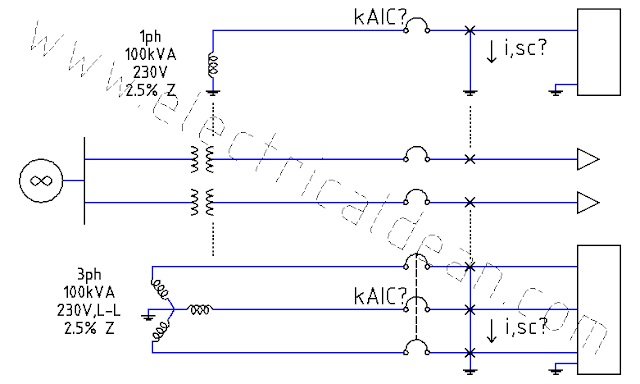Circuits - Scenario 1
This post presents a simple circuit that can be thought of as a basic model for conductor cables in large wiring installations, such as in big residential apartments, tall commercial buildings, or wide industrial complexes, where short-circuit or ground fault currents may not be enough to kick a circuit breaker open.
In such cases, the fault condition will simply become what is known as a "phantom load". It unnecessarily heats up the cable and contributes to the energy consumption even when electrical appliances are unplugged.
As cable length increases, conductor resistance and reactance become more evident, hence the need to consider them carefully in wiring design calculations.
SITUATION
A 0.0001-henry inductor is connected in series with 40-ohm resistor. If the supply is 220 Volts at 60 Hertz, what is the current flowing through the circuit?
ANALYSIS
1.) Inductive reactance, vector:
X-> = jwL = j 2 pi f L
2.) Impedance, vector:
Z-> = R-> + X->
Z-> = (40 + (j 2 pi 60 * 0.0001)) ohms
Z-> = (40 + j 0.0377) ohms
Z-> = 40 ohms < 0.054
3.) Current, vector:
i-> = V-> / Z->
i-> = 220V<0 / (40 ohms <0.054)
i-> = 5.5A < -0.054
CONCLUSION
The current is 5.5 Amperes, lagging.
Under 2017 PEC Table 2.40.1.6(A) [ or 2017 NEC Table 240.6(A) ], the standard ampere ratings for circuit breakers start at 15 Amperes. A current of 5.5A from such fault condition is clearly not enough to trip a standard circuit breaker.
In such cases, the fault condition will simply become what is known as a "phantom load". It unnecessarily heats up the cable and contributes to the energy consumption even when electrical appliances are unplugged.
As cable length increases, conductor resistance and reactance become more evident, hence the need to consider them carefully in wiring design calculations.
SITUATION
A 0.0001-henry inductor is connected in series with 40-ohm resistor. If the supply is 220 Volts at 60 Hertz, what is the current flowing through the circuit?
ANALYSIS
1.) Inductive reactance, vector:
X-> = jwL = j 2 pi f L
2.) Impedance, vector:
Z-> = R-> + X->
Z-> = (40 + (j 2 pi 60 * 0.0001)) ohms
Z-> = (40 + j 0.0377) ohms
Z-> = 40 ohms < 0.054
3.) Current, vector:
i-> = V-> / Z->
i-> = 220V<0 / (40 ohms <0.054)
i-> = 5.5A < -0.054
CONCLUSION
The current is 5.5 Amperes, lagging.
Under 2017 PEC Table 2.40.1.6(A) [ or 2017 NEC Table 240.6(A) ], the standard ampere ratings for circuit breakers start at 15 Amperes. A current of 5.5A from such fault condition is clearly not enough to trip a standard circuit breaker.





Comments
Post a Comment